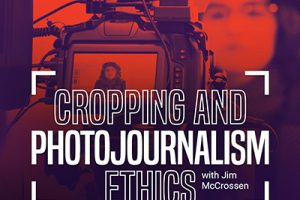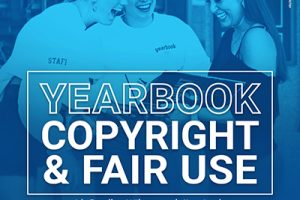Copyright
What the Law Means to Your Yearbook
As anyone who has ever struggled to drive within the speed limit can tell you, the law can be both a friend and a foe. It sets parameters for acceptable behavior that can help make the world run more fairly, smoothly and safely. But it can also limit our freedom, forcing us to follow someone else’s rules or pay a price for ignoring them.
Copyright law is a good example of this dual nature of the law. While the federal copyright statutes protect journalists against the unauthorized use of their stories, artwork or photographs, it also limits their ability to use the works of others without permission. Copyright is also one of the most important areas of press law for yearbook journalists and their advisers to understand. My discussions with hundreds of high school yearbook staffs each year suggests that some students still have a lot to learn.
What Is Copyright?
A copyright is a property right; it is not that different from owning a car or a stereo. Just as you could be sued for using someone else’s car without the owner’s permission, you can be sued for using someone’s copyrighted work without first obtaining the owner’s consent.
Copyright law intends to encourage and reward the creativity of authors and artists. If, for example, someone could take a popular novel, reprint it and sell the copies without the author’s permission (or any payment to the author), that author would have much less incentive to invest the time, energy and resources necessary to write the book in the first place. Copyright law helps to ensure a growing collection of original works available for public enjoyment and benefit.
Relationship to Trademark Law
Copyright is just one means of providing legal protection for creative works. Trademark law protects the symbols and slogans that identify businesses to their consumers. Together with patent law, these two comprise the area of the law known as “intellectual property.”
Trademark law presents relatively few concerns for yearbooks. While copyright protects a creator’s rights, trademark law is more a protection for consumers. Trademarks – for example, the Nike “swoosh” symbol, the brand name “Coke,” or the yellow Kodak film box- are unique symbols, names or other “marks” that companies use and consumers rely on to distinguish one product or service from another. Trademark law is generally only a problem when a trademark or service mark is used in a way that would confuse a potential consumer. That is why, for example, there would be no problem with a student yearbook publishing a photograph of a pair of Nike shoes (complete with the “swoosh”) to illustrate a feature story on popular footwear worn by students. There is, obviously, no likelihood that a consumer would pick up the yearbook thinking it was a Nike shoe – or, if published in relationship to a news story, even an official Nike publication.
Note, however, that some works are protected by both trademark and copyright law at the same time, and you will need to analyze your intended use under each. If your yearbook editors wanted to use a flashy Nike ad simply to “decorate” an inside page (and not as part of some specific yearbook coverage), the outcome would be different. Again, there would be no trademark problem. A student yearbook and athletic shoes are so different that no consumer would be confused by the use. However, the ad is also protected by copyright and its unauthorized use will be prohibited unless the editor could demonstrate a “fair use.”
Facts and Ideas Not Subject to Copyright Protection
Copyright law also recognizes a distinction between “expression” and “ideas.” Only creative expression, not ideas and facts, qualifies for copyright protection. So while Time magazine would have a copyright interest in the exact words and organization of an article it published on teen drug use, the facts included there belong to no one and can therefore be used as a source for other reporters. Good ethics would suggest one should attribute such information to its source, but copyright law does not require it.
What Formalities Does Copyright Require?
Under copyright law today, any original work is protected the moment it is put in some tangible form such as words or design on paper or computer disk, or image on film or video.However, there are three additional methods for obtaining stronger copyright protection: notice, registration and deposit.
A formal copyright notice includes the copyright symbol “©” or the word “copyright,” the creation date and the name of the copyright holder. One needs no special permission to include a copyright notice on their work. In fact, placing such notice on your yearbook is a smart idea to protect your publication from unauthorized use and to let others know who the copyright owner is. One copyright notice in a prominent place such as the title page or colophon will protect everything in the book except for the advertisments.
The second method of additional protection is registration of creative works with the Copyright Office in Washington, D.C. Registration is the key to the courthouse door. Only a copyright owner who has registered his work with the Copyright Office may sue someone who infringes on his copyright. Additionally, although you have the right to register your work at any time while your copyright is in effect, certain damages and reimbursement for your attorney fees should you have to sue are only available to those who formally register their work within three months of publication.
The registration process is not complicated. It requires completing a form for the Copyright Office, mailing them two copies of your work and paying a small fee (for most yearbooks, it would be $20). Most student publications do not find registration worth the effort and expense, but if you are publishing some photos or other material that you think might be valuable someday, it might be worth considering.
The final copyright formality is deposit. Creators must deposit two copies of their work with the Copyright Office within three months of publication. These deposits help form the collection of the Library of Congress in Washington, D.C. While copyright law mandates deposit, failure to send in the required copies of your work will not in any way affect the validity of your copyright. If you plan to register your copyright later, you can request a receipt for your deposit so you do not have to include more copies of your work with your registration application. Questions about any aspect of copyright registration or deposit can be directed to an information specialist at the U.S. Copyright Office at (202) 707-5959.
How Long Does Copyright Protection Last?
Calculating the length of copyright protection can be a complicated task. It can also be important because once copyright expires, the work becomes part of the public domain and can be used without permission from the former copyright owner. For example, film producers in Hollywood were able to create a movie of Nathaniel Hawthorne’s book, The Scarlet Letter, in 1995 with no fear of copyright infringement because the novel (written in 1850) is in the public domain. For works created after Jan. 1, 1989, copyright generally will last for the life of the creator, plus 50 years. The copyright for works created by a company lasts for either 75 years from publication or 100 years from creation, whichever comes sooner. Copyright always expires on Dec. 31 of the appropriate year.
What Remedies Are Available to Copyright Owners?
Copyright owners who have complied with the requisite formalities may sue for copyright infringement if someone has exercised one of the copyright owner’s exclusive rights without permission or in a manner that would not be considered a fair use. If the copyright owner prevails in the lawsuit, the court can award damages, as well as injunctive relief and impoundment of the infringing material.
Obtaining Permission to use a Copyrighted Work
The surest way to use a copyrighted work legitimately is to get permission from the copyright holder. Contrary to a widespread misconception, giving the copyright owner credit is not enough to avoid an infringement claim. The law says permission is required. Sometimes obtaining that permission is not difficult. For example, a local commercial newspaper would probably agree to allow your yearbook to reprint a photo of a local news event, as long as the students gave credit to their source. On the other hand, getting permission can sometimes pose a challenge. Many corporations have strict policies regulating the use of their copyrighted work, from barring permission altogether to detailed, time-consuming procedures by which permission must be secured to charging expensive licensing fees.
If you think it will be necessary to obtain copyright permission, start early. While the time required varies, you should allow yourself months, rather than days or even weeks, to secure copyright permission.
Fair Use
“Fair use” is an important exception to the general rule that copyrighted material cannot be used without permission. It is particularly significant to the news media, which is in the business of conveying information, some of it based on copyrighted work. Federal copyright law says that an individual other than the copyright owner can use a copyrighted work without permission if the use would be considered a “fair use.” The fair use doctrine is, in effect, a compromise. It represents a balance by lawmakers of the desire to encourage the creation of original works against society’s need for readily accessible information. Recognizing the inherent conflict in these two goals, fair use strives to find a reasonable middle ground.
Whether or not the use of a copyrighted work by a non-owner would be considered a “fair use” is seldom an easy call. There is no black and white rule; each case must be examined on its own merits. Courts look at four factors to determine if the use of a copyrighted work is a fair use:
- The purpose and character of the use. Non-commercial uses for purposes like news reporting, teaching, criticism, or commentary are more likely to be allowed.
- The nature of the copyrighted work. Uses of works containing mostly factual material like maps or biographies are more likely to be fair than uses of highly creative and original works like novels and cartoons.
- How much of the original work is used. No more of the work than what is necessary may be used for it to be considered a fair use. The test is both quantitative (using 20 words from a 200,000-word book will probably be a fair use; using 20 words of a 50-word poem would probably not be and qualitative (using the “core” or “heart” of a work – no matter how small -is less likely to be a fair use).
- The effect of the use on the commercial value of the copyrighted work. This is typically the most important factor. If consumers are willing to buy the use of the copyrighted work as a substitute for the original, it probably will not qualify as a fair use.
Fair use, therefore, authorizes the use of limited amounts of copyrighted works for purposes like news reporting and education so long as the use does not destroy the commercial value of the copyrighted work. Thus, a yearbook could probably reproduce the cover art from a CD to illustrate a feature about popular music from the year without obtaining the artist’s (or a record company’s) permission. But printing all the lyrics from the senior class song on the inside cover of the yearbook will probably not be a fair use.
Parody
Copyright law gives parodies and spoofs a fair share of breathing room. The U.S. Supreme Court has ruled recently that the use of copyrighted material in parodies or spoofs can constitute a fair use if the use satisfies certain conditions. First, the parody must be obvious. The audience must reasonably perceive that the use is a criticism of or commentary on the original. A disclaimer or notice that clearly alerts readers of the parody may prove useful. Second, the use must reproduce no more of the work than the minimum necessary to conjure up the original in the audience’s mind. A slight change in the appearance of a cartoon character will be insufficient to satisfy fair use as a parody of the character. For example, your staff artist’s detailed rendition of the characters Beavis and Butthead commenting about rock videos would probably not qualify as a parody fair use; a drawing of two teenage boys who vaguely resemble Beavis and Butthead giggling about school events probably would. Finally, the use must not destroy the market of the original work. If the public might buy the use instead of buying the original or a parody of the original created by the copyright owner, then the use is not fair.
The basics of copyright law are not difficult to understand, particularly when you consider the reasoning behind the law. But if you need additional help, contact a local lawyer with some expertise in copyright law, your yearbook company or the The Student Press Law Center. Student publications are rarely threatened with copyright infringement lawsuits, but when they are, the consequences can be devastating.
Tag:copyright




4 Comments
What about a high school providing yearbook individual photos of some graduates (from the 1967 yearbook !) to an author of a book for use in the book the author has written about events in the school in 1967 in which the graduates pictured played a role?
What about yearbooks being scanned and published on the internet? Is there a copyright that protects yearbooks?
My son drew a picture with “fred flinstone” on it (and a bear)..for his year book cover.
and wrote his school was the best since the “stone age”
His picture won first place in the contest, and now people are saying
it’s copywright because he drew Fred Flinstone. Is this true??
Does a student photographer who was assigned to a particular event and who used her own camera have the right to use the photos as she deems appropriate- or- are they property of the yearbook until it is published and the photos are no longer novelty?